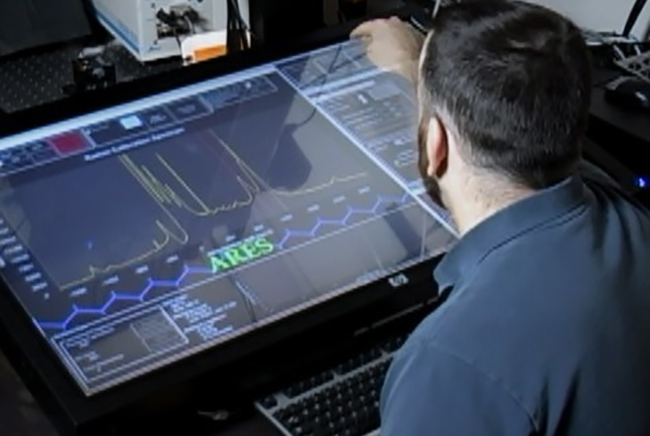
A materials researcher examines experimental data on the ARES artificial intelligence planner. The ARES Autonomous Research System, developed by the Air Force Research Laboratory, uses artificial intelligence to design, execute and analyze experiments at a faster pace than traditional scientific research methods. Air Force photo.
A new Air Force report suggests elevating a cross-cutting Air Force Research Laboratory team to “prioritize and coordinate” the lab’s entire autonomy portfolio at a crucial moment for development in that area.
Three years later than expected, the Air Force last month released the second volume in its “Autonomous Horizons” series of reports on the future of artificial intelligence and autonomy.
Written by Greg Zacharias, the service’s former chief scientist, the report is a call to action for senior leaders and lays out potential avenues for learning more about autonomy and AI. The service is already moving out on multiple fronts, designing self-piloted combat aircraft, envisioning command-and-control systems that analyze options for users, and more.
“We will not be able to continue with incremental advances on concepts developed decades ago,” Zacharias, the Air Force’s top science adviser from 2015-2018, argues in the report. “Instead, we need new technologies, affording us new capabilities, and new operational concepts to employ them.”
Last year, AFRL launched the Autonomy Capabilities Team 3, or ACT3, to focus personnel resources from across the lab on the problem of AI. Inside Defense reported in May 2018 the rapid-development team, which oversees the Air Force Office of Scientific Research’s AI portfolio, is taking on projects like designing an autonomous fighter jet, adding autonomy into intelligence data-processing systems, and offering a “do-it-yourself” AI-development platform to airmen.
The Air Force did not provide an update by press time on ACT3’s progress.
While Zacharias’s report does not name ACT3, the document envisions a potentially bigger role for such a team than ACT3 currently holds. The report asserts an Autonomy Capabilities Team could decide where money would have the biggest impact for autonomy and ensure projects across the lab could benefit from the findings.
The suggestion comes as the Air Force starts thinking about overarching portfolios instead of individual programs and recently released a plan to revamp the service’s science and technology enterprise.
“The AFRL, and specifically the ACT, cannot simply limit its attention to the research space of autonomous systems—nor can it simply perpetuate the model of applying modern AI and [autonomous systems] technology to provide incremental mission capability improvement in one-off demonstrations,” the report states. “When successful, the ACT can serve as an ‘existence proof’ of how AFRL can transform itself from its legacy of a discipline-focused organization to one that is more cross-disciplinary and project-oriented, solving transformative, USAF enterprise-wide problems.”
The research world now offers a perfect storm of growing knowledge about how cognition works, innovative uses for AI algorithms, and leaps in computational capabilities. Put together, those changes will allow the military to act faster and in places where humans cannot using autonomy.
“A potentially more far-reaching payoff will come from becoming more information-centric and aided by proliferating autonomous systems, so that we can leave our legacy platform-centric way of thinking behind and become an enterprise that is service-oriented, ubiquitously networked, and information intensive,” Zacharias wrote.
Instead of viewing autonomy through the lens of what a specific platform is designed to do, the report characterizes Air Force assets by how they connect and use data—an approach that mirrors the service’s goals more broadly.
In addition to developing transformational new technologies, the report recommends the Air Force continue moving away from traditional “waterfall” development and towards iterative wargaming, prototyping, and testing. Zacharias also says AFRL needs restructuring so it can pursue cross-disciplinary ideas that span each level of research.
To make strides in this area, the Air Force needs to pursue challenging technologies that “support not only the basic ‘see/think/do’ functions but also those that enable effective human-computer interfaces, learning/adaptation, and knowledge-base management, both of a general purpose and of a domain-specific nature,” according to the report.
The service also has to figure out how to make these systems good at what they do, trusted by humans, and able to adapt to unexpected changes.
The first Autonomous Horizons volume laid out a future vision in 2015. Inside Defense reported the second part was due out in summer 2016, with a third volume to follow. After a long break, the newly released second volume no longer mentions a third publication. Volume III was envisioned to delve into cyber issues, command and control, and verification and validation of autonomy software.
